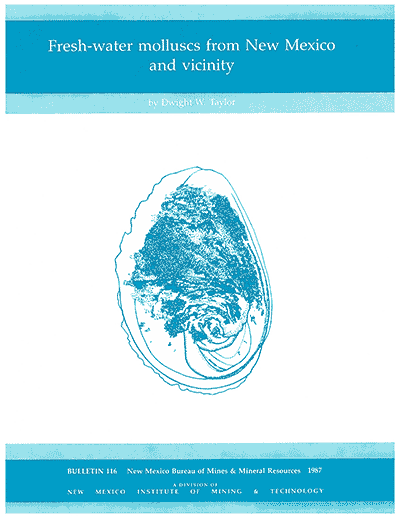
Bulletin 116—Fresh-water molluscs from New Mexico and vicinity
By D. W. Taylor, 1987, 50 pp., 51 tables, 24 figs.

Nine new species of molluscs are described from New Mexico, four from Arizona, two from Utah, and five from Texas, with redescriptions of two more from New Mexico and Texas. These 22 species are classified in Assimineidae (one species of Assiminea), Hydrobiidae (11 species of Fontelicella and two monotypic new genera, Apachecoccus and Yaquicoccus), Littoridinidae (seven species of Tryonia), and Sphaeriidae (one species Pisidium). Virtually all are narrowly local forms, and have been considered actually or potentially endangered species. Geological significance of these species lies in the drainage history of the region. They conform to previous geological interpretations in showing that they evolved in separate drainages of Pliocene or older times, which have been united into the present stream systems.
The species described in this bulletin were collected during studies by the NM Department of Game and Fish, Santa Fe, through J. P. Hubbard; and by the NM Bureau of Mines and Mineral Resources, Socorro. The studies have been carried out partly to assess potentially threatened and endangered species of the State fauna and partly in preparation of a regional manual of the fresh-water molluscan fauna of NM and adjacent areas, including the Rio Grande drainage generally.
One of the goals of the study in NM and adjacent areas has been to test the value of fresh-water molluscs in indicating past river drainages. NM is particularly suitable, because history of the Rio Grande has been of interest to many geologists. A variety of geological data, including radiometric dates, is available. Previous interpretations provide alternatives with which to compare data from aquatic molluscs.
Application of the distribution of fresh-water snails and clams to interpretation of geologic history requires that the species be limited to perennial water at all stages of life; that range of habitat and dispersion be known at least generally; and that affinities of the species be understood. Among the small snails of the Hydrobiidae and Littoridinidae, forming so much of the Southwest fauna, shell features are usually no indication of relationships and the fossil record is unlikely to prove illuminating. From the broad-brush studies completed so far, it appears that the thermal-spring species are generally ancient, perhaps mid-Tertiary in age, and that differentiation in Tyronia is substantially slower than in most Hydrobiidae. Within the fauna described herein this contrast is evident in the upper Rio Grande and Pecos River. The species of Fonticella are sharply distinct. The species of Tyronia are related. As a rule of thumb, it may be that the Fonticellas are Pliocene and the Tyronias are Miocene. Whether this is due to intrinsically different rates of speciation, or is determined to some extent by habitat remains to be studied.
In NM and adjacent areas, distribution of the spring and spring-brook snails show a clear-cut dividing line. This line runs southeast along the Mogollon Highlands of Arizona and into Chihuahua, parallel to the Rio Grande between the NM border and the Big Bend. All species of Tyronia are northeast of this line. All Fonticellas on the northeast are of the Fonticella californiensis series, related to the species of Utah west of the Colorado River. Southwest of this line, the Tyronias are Tyronia and Fonticellas all are of the Fonticella stearnsiana group within the stearnsiana series. This clear separation of so many species is evidently due to some geologic feature of mid-Tertiary of greater age, but the data are so generalized that any precise interpretation would be premature.
$7.50
Buy
Now
Also available as a free download.
Download
| File Name | Size | Last Modified |
|---|---|---|
| B116.pdf | 7.49 MB | 01/15/2021 11:04:32 AM |



